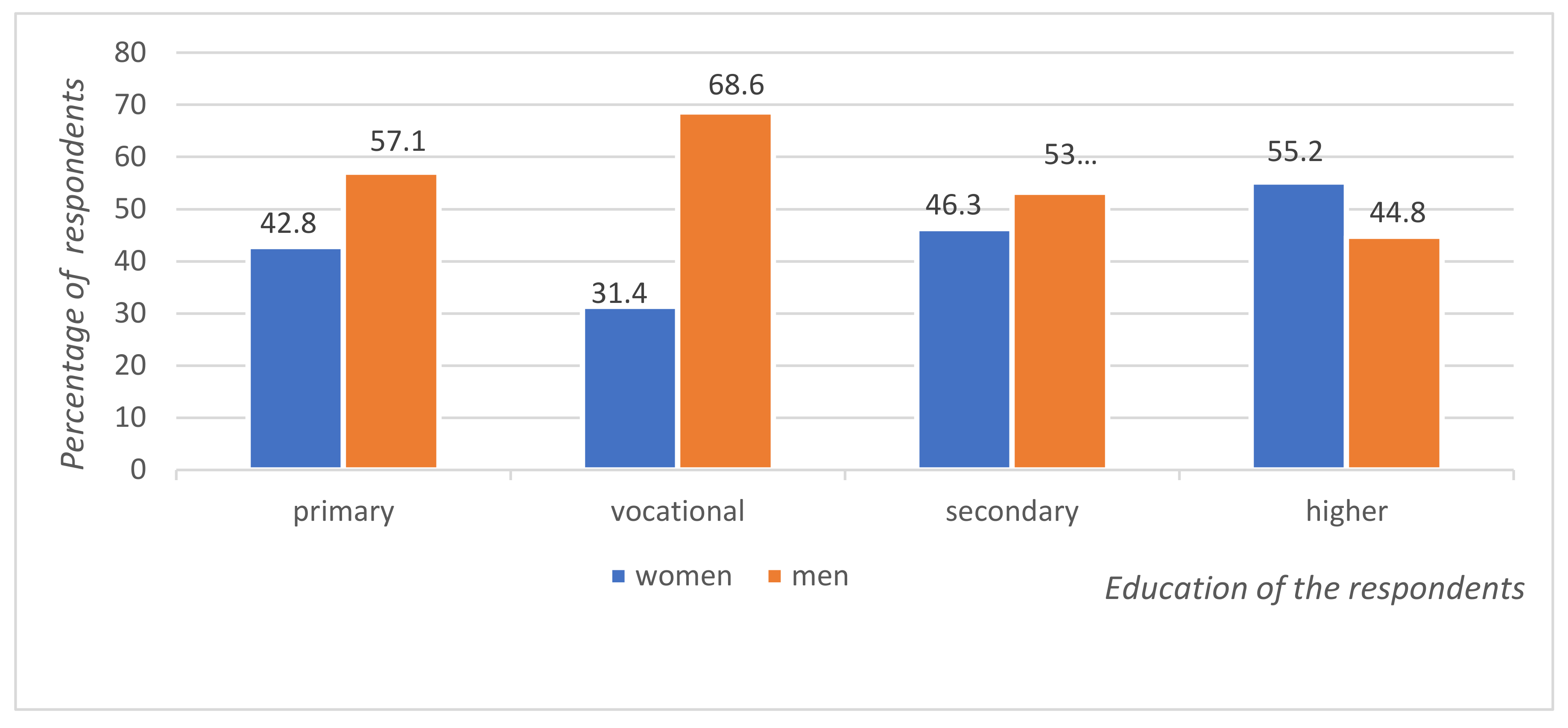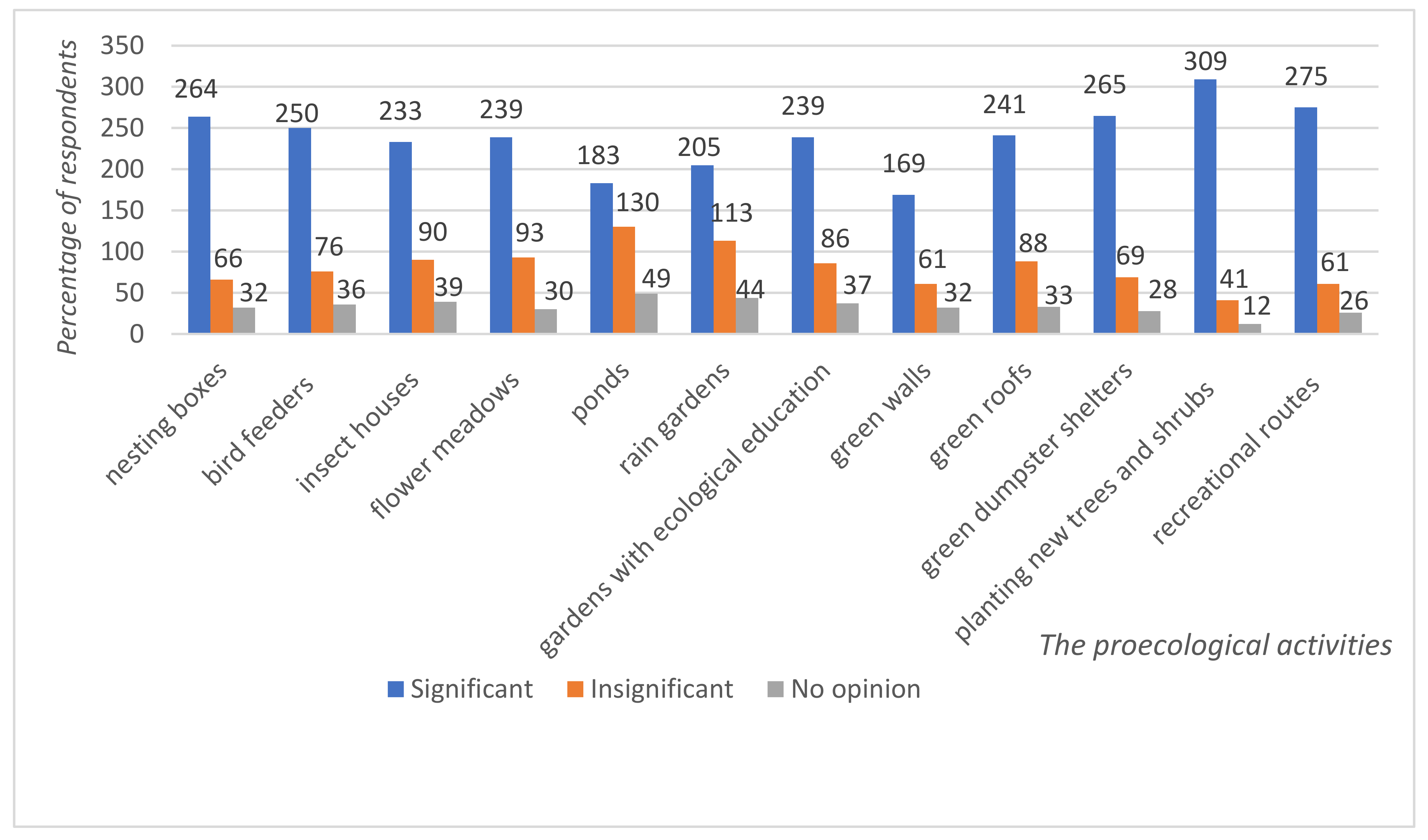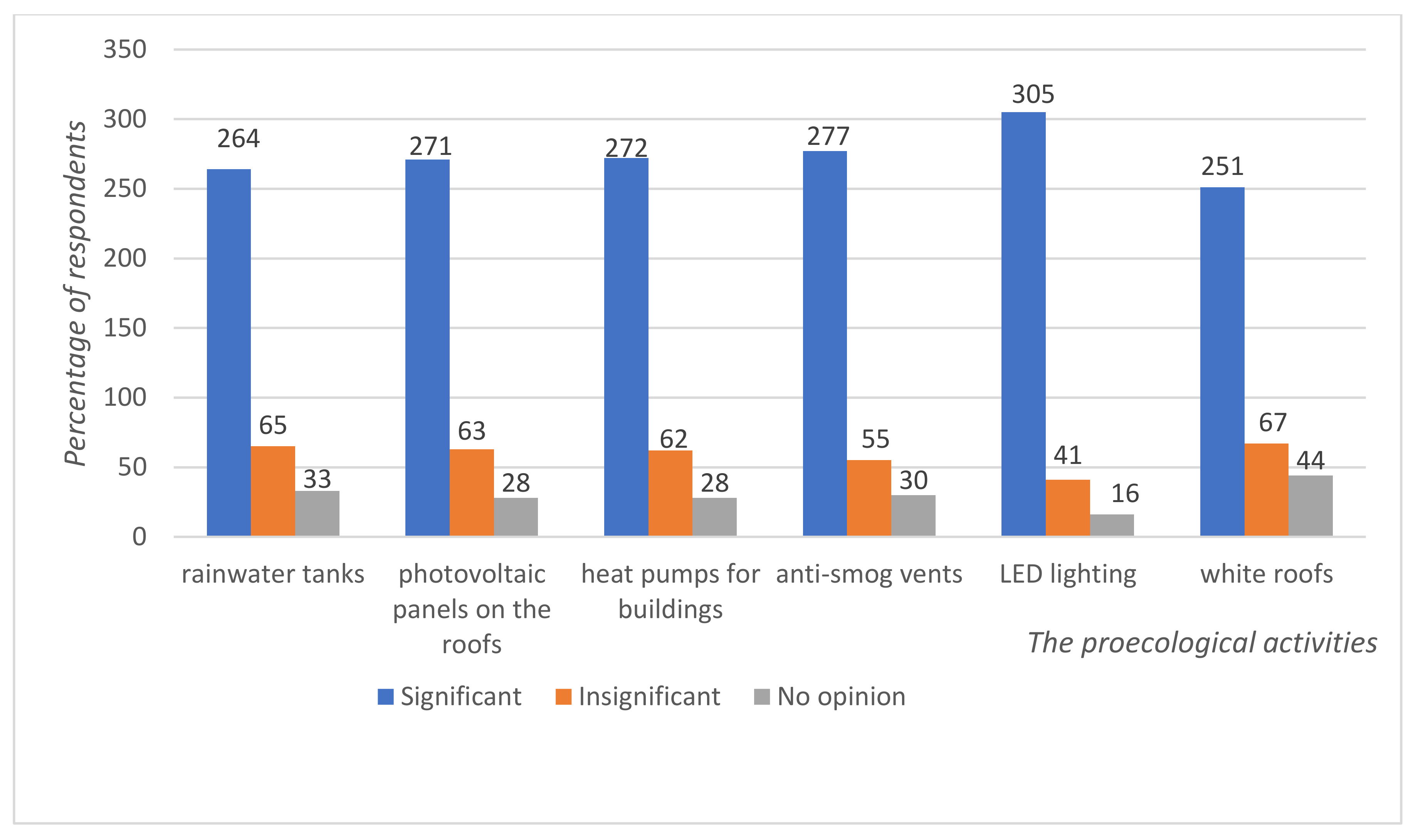Innovative Ecological Transformations in the Management of Municipal Real Estate
Abstract
1. Introduction
2. Characteristics of Innovative Ecological Solutions Implemented in Housing
- Ensuring the ecological safety of the country;
- Preserving biodiversity;
- Ensuring the improvement of the condition of the environment;
- Eliminating threats posed by urbanization, automotive, waste production, and energy consumption processes;
- All industrial plants with environmental protection requirements complying to the above activities.
3. Innovative Solutions in City Logistics
4. Characteristics of Sociodemographic Data
- s—Standard deviation;
- —Mean;
- x—Another observation in the sample;
- N—Number of people in the sample.
5. Presentation of Research Results from the Study Material and Comparing It with the Possessed Theoretical Knowledge
- −
- Placing bird feeders, nesting boxes, and houses for insects in the property space;
- −
- Creation of flower meadows, ponds, rain gardens, gardens with ecological education, green walls, green roofs, and green dumpster shelters;
- −
- Planting new trees and shrubs;
- −
- Creating recreational routes;
- −
- Installation of rainwater tanks, photovoltaic panels on the roofs, heat pumps for buildings, anti-smog ventilators, and LED lighting;
- −
- Development and construction of white roofs.
6. Discussion
7. Conclusions
Funding
Institutional Review Board Statement
Informed Consent Statement
Data Availability Statement
Conflicts of Interest
References
- Dziadkiewicz, M.; Cichowski, P. Participation of Tenants and the Quality of Management Services of Communal Apartments. Eur. J. Serv. Manag. 2018, 26, 61–69. [Google Scholar] [CrossRef]
- Dziadkiewicz, M.; Bajdor, P. Social Innovations in Municipal Housing Management. In Education Excellence and Innovation Management: A 2025 Vision to Sustain Economic Development during Global Challenges, Proceedings of the 35th International Business Information Management Association Conference (IBIMA), 1–2 April 2020, Seville, Spain; International Business Information Management Association: Seville, Spain; pp. 9151–9163.
- Dziadkiewicz, M. Organizational Models for the Management of Municipal Housing Resources. In Koncepcje Zarządzania Zadaniami Własnymi Realizowanymi Przez Samorząd Terytorialny; Ulfik, A., Ed.; Wydawnictwo Akademii Wychowania Fizycznego w Katowicach: Katowice, Poland, 2015; pp. 69–91. (In Polish) [Google Scholar]
- Łaguna, T.M.; Witkowska-Dąbrowska, M. Podstawy Zarządzania Środowiskiem i Zasobami Naturalnymi, Wyd; Ekonomia i Środowisko: Białystok, Poland, 2005; p. 9. [Google Scholar]
- Kobyłko, G. Proekologiczne Zarządzanie Przedsiębiorstwem; Wydawnictwo Akademii Wychowania Fizycznego w Katowicach: Katowice, Poland, 2007; p. 56. (In Polish) [Google Scholar]
- Geels, F.W.; Deuten, J.J. Local and global dynamics in technological development: A socio-cognitive perspective on knowledge flows and lessons from reinforced concrete. Sci. Public Policy 2006, 33, 265–275. [Google Scholar] [CrossRef]
- About-de Chastenet, C.; Belziti, D.; Bessis, B.; Faucheux, F.; Le Sceller, T.; Monaco, F.-X.; Pech, P. The french eco-neighbourhood evaluation model: Contributions to sustainable city making and to the evolution of urban practices. J. Environ. Manag. 2016, 176, 72. [Google Scholar]
- Butler, T.; Hackney, R. The role of informational mechanisms in the adoption of Green IS to achieve eco-sustainability in municipalities. Inf. Manag. 2021, 58, 103320. [Google Scholar] [CrossRef]
- Koebel, C.T. Innovation in homebuilding and the future of housing. J. Am. Plan. Assoc. 2008, 74, 45–58. [Google Scholar] [CrossRef]
- Dz.U. Kancelaria Sejmu. Ustawa z 27 Kwietnia 2001 r.—Prawo Ochrony Środowiska; 62, poz 627; Dz.U. Kancelaria Sejmu: Warszawa, Poland, 2001. Available online: www.isap.sejm.gov.pl (accessed on 22 September 2022). (In Polish)
- Hodson, M.; Marvin, S. Cities mediating technological transitions: Understanding visions, intermediation and consequences. Technolology Anal. Strateg. Manag. 2009, 21, 515–534. [Google Scholar] [CrossRef]
- Polska 2025. Długookresowa Strategia Trwałego i Zrównoważonego Rozwoju; Ministerstwo Środowiska: Warszawa, Poland, 2007; p. 13. Available online: www.mrr.gov.pl (accessed on 17 June 2022).
- Kabus, J.; Jędrzejas, N.; Mynarzova, M. Environmental Sustainability Management on the Example of Selected European Cities. In Proceedings of the 4 International Conference on European Integration, Ostrava, Czech Republic, 17–18 May 2018; pp. 605–618. [Google Scholar]
- Howaniec, H. Działania Prośrodowiskowe Jako Element Odpowiedzialności Przedsiębiorstw. In Wyzwania dla Zarządzania Współczesnym Przedsiębiorstwem; Borowiecki, R., Jaki, A., Eds.; Wyd.DEOE: Kraków, Poland, 2009; p. 109. [Google Scholar]
- Ibrahim, I. Livable Eco-Architecture. Procedia Soc. Behav. Sci. 2016, 216, 46–55. [Google Scholar] [CrossRef]
- Francese, D.; Mensitieri, G.; Iannace, S.; Balestra, C. New Materials for Ecological Building Products. In Characterization and Development of Biosystems and Biomaterials Advanced Structured Materials; Springer: Berlin/Heidelberg, Germany, 2013; p. 209. [Google Scholar]
- Guo, Q.; Liang, Q.Y.; Zhao, L.Q. Ecological Development of Building Materials. In Advanced Materials Research; Trans Tech Publications Ltd.: Bäch SZ, Switzerland, 2013; p. 887. [Google Scholar]
- Osho, M. Wolność, samotność. In Nowe Spojrzenie na Związki Między Ludźmi; Wydawnictwo Czarna Owca: Warszawa, Poland, 2015; p. 84. [Google Scholar]
- Smith Morris, E. Down with eco-towns! Up with eco-communities. Or is there a need for model eco-towns? A review of the 2009–2010 eco-town proposals in Britain. In Eco-City Planning: Policies, Practice and Design. Dordrecht; Wong, T.-C., Yuen, B., Eds.; Springer: Berlin/Heidelberg, Germany, 2011; pp. 114–116. [Google Scholar]
- Hołdys, A. “Kiedy zaczyna się wiosna?”. Wiedza i Życie 2015, 3, 6–10. (In Polish) [Google Scholar]
- Fidor, J. Ekologiczne osiedla w Polsce—Tendencje i perspektywy. Arch. Artibus 2017, 3, 39. [Google Scholar]
- Report European Commission. Promoting Sustainable Urban Development in Europe-Achievements and Opportunities; European Union—Regional Policy: Brussels, Belgium, April 2009. [Google Scholar]
- Kabus, J.; Nowakowska-Grunt, J. Uwarunkowania rozwoju lokalnego na przykładzie powiatu częstochowskiego. Tur. I Rozw. Reg. T 2016, 5, 39–47. [Google Scholar] [CrossRef]
- Pow, C.P.; Neo, H. Seeing red over green: Contesting urban sustainabilities in China. Urban Stud. 2013, 50, 2262. [Google Scholar] [CrossRef]
- Shiuh-Shen, C. Chinese eco-cities: A perspective of land-speculation-oriented local entrepreneurialism. China Inf. 2013, 27, 185. [Google Scholar] [CrossRef]
- van Dijk, M.P. Three ecological cities, examples of different approaches in Asia and Europe. In Eco-City Planning: Policies, Practice and Design; Wong, T.-C., Yuen, B., Eds.; Springer: Berlin/Heidelberg, Germany, 2011; p. 49. [Google Scholar]
- Kabus, J. Development of Entrepreneurship with Support of Local Self-Governments, on the example of Belchatow County. Zesz. Nauk. Politech. Częstochowskiej 2017, 27, 162–171. [Google Scholar] [CrossRef]
- Joss, S. Eco-cities: The mainstreaming of urban sustainability–key characteristics and driving factors. Int. J. Sustain. Dev. Plan. 2011, 6, 271. [Google Scholar] [CrossRef]
- Joss, S. Eco-cities and sustainable urbanism. Int. Encycl. Soc. Behav. Sci. 2015, 2, 831. [Google Scholar]
- Manso, M.; Castro-Gomes, J. Green wall systems: A review of their characteristics. Renew. Sustain. Energy Rev. 2015, 41, 863–871. [Google Scholar] [CrossRef]
- Klopp, J.M.; Petretta, D.L. The urban sustainable development goal: Indicators, complexity and the politics of measuring cities. Cities 2017, 63, 92–97. [Google Scholar] [CrossRef]
- Kline, E. Planning and creating eco-cities: Indicators as a tool for shaping development and measuring progress. Local Environ. 2000, 5, 345. [Google Scholar] [CrossRef]
- Afiff, S.A. Challenges to implementing the eco-city concept in Indonesia’s major cities. In Towards a Liveable and Sustainable Urban Environment: Eco-Cities In East Asia; Lye, L.F., Chen, G., Eds.; World Scientific Publishing: Singapore, 2010; p. 139. [Google Scholar]
- Lye, L.F.; Chen, G. Towards eco-cities in East Asia. In Towards a Liveable and Sustainable Urban Environment: Eco-Cities in East Asia; Lye, L.F., Chen, G., Eds.; World Scientific Publishing: Singapore, 2010; pp. 15–17. [Google Scholar]
- Surjan, A.; Shaw, R. “Eco-city” to “disaster-resilient eco-community”: A concerted approach in the coastal city of Puri, India. Sustain. Sci. 2008, 3, 259. [Google Scholar] [CrossRef]
- Włodarczyk, R.; Zarzycki, R.; Bis, Z. Combined System of Energy Generation from Biomass and Solar Energy. In Proceedings of the E3S Web of Conferences, SOLINA 2018—VII Conference SOLINA Sustainable Development: Architecture—Building Construction—Environmental Engineering and Protection Innovative Energy—Efficient Technologies—Utilization of Renewable Energy Sources, Polańczyk, Poland, 19–23 June 2018; p. 00132. [Google Scholar] [CrossRef]
- Kenai, M.-A.; Libessart, L.; Lassue, S.; Defer, D. Impact of plants occultation on energy balance: Experimental study. Energy Build. 2018, 162, 208–218. [Google Scholar] [CrossRef]
- Faucheux, S.; Nicolaï, I. IT for green and green IT: A proposed typology of ecoinnovation. Ecol. Econ. 2011, 70, 2020–2027. [Google Scholar] [CrossRef]
- Sexton, M.; Barrett, P. Performance-based building and innovation: Balancing client and industry needs. Build. Res. Inf. 2005, 33, 142–148. [Google Scholar] [CrossRef]
- Srivastava, M.; Kumar, V. The methods of using low cost housing techniques in India. J. Build. Eng. 2018, 15, 102–108. [Google Scholar] [CrossRef]
- Janasz, M.; Kałużyński, P. Zielona Infrastruktura Wyzwaniem dla Logistyki Miejskiej. In Różne Oblicza Logistyki: Zbiór Prac Studentów; Motowidlak, U., Wronkowski, D., Reńda, A., Eds.; WUŁ: Łódź, Poland, 2018; pp. 161–176. (In Polish) [Google Scholar] [CrossRef][Green Version]
- Gorgoń, J. Znaczenie i rola błękitno-zielonej infrastruktury w adaptacji do zmian klimatu. Available online: https://www.ietu.katowice.pl/aktual/Poleko2016/4_Gorgon_J_Znaczenie_i_rola_BZI_w_adaptacji_do_zmian_klimatu_zab.pdf (accessed on 20 April 2017). (In Polish).
- Petrini, K.; Rosasco, P. Is greening the building envelope economically sustainable? Ananalysis to evaluate the advantages of economy of scope of verticalgreening systems and green roofs. Urban For. Urban Green. 2016, 20, 328–337. [Google Scholar] [CrossRef]
- Manso, M.; Teotonio, I.; Silva, C.M.; Cruz, C.O. Green roof and green wall benefits and costs: A review of the quantitative evidence. Renew. Sustain. Energy Rev. 2021, 135, 110111. [Google Scholar] [CrossRef]
- Puzdrakiewicz, K. Green infrastructure as a multifunctional tool of sustainable development. Stud. Miej. 2017, 27, 155–174. [Google Scholar] [CrossRef]
- Serra, V.; Bianco, L.; Candelari, E.; Giordano, R.; Montacchini, E.; Tedesco, S.; Larcher, F.; Schiavi, A. A novel vertical greenery module system for building envelopes: Theresults and outcomes of a multidisciplinary research project. Energy Build. 2017, 146, 333–352. [Google Scholar] [CrossRef]
- Raport Budownictwo. Innowacje. Wizja Liderów Branży, 2025, 19–25. Available online: www.unibep.pl/www.unibep.pl/ (accessed on 17 June 2022).
- Slaughter, E.S. Implementation of construction innovations. Build. Res. Inf. 2000, 28, 2–17. [Google Scholar] [CrossRef]
- Suchocka, M. Tree as a Part of the Green Infrastructure [Drzewo Jako Element Zielonej Infrastruktury]. Probl. Ekol. Kraj. 2013, T: XXXVI, 85–94. [Google Scholar]
- Wolf, K.L. Business District Streetscapes, Trees and Consumer Response. J. For. 2005, 103, 396–400. [Google Scholar]
- Egorov, A.I.; Mudu, P.; Braubach, M.; Martuzzi, M. World Health Organization, Regional Office of Europe. In A Review of Evidence; WHO: Geneva, Switzerland; Bonn, Germany, 2016. [Google Scholar]
- Bras, A.; Ravijanya, C.; de Sande, V.T.; Rley, M.; Ralegaonkar, R.V. Sustainable and affordable prefab housing systems with minimal whole life energy use. Energy Build. 2020, 220, 110030. [Google Scholar] [CrossRef]
- Caprotti, F. Eco-urbanism and the eco-city, or, denying the right to the city? Antipode 2014, 46, 1295. [Google Scholar] [CrossRef]
- Lee, S.H.L.; Jim, C.Y. Energy benefits of green-wall shading based on novel-accurate apportionment of short-wave radiation components. Appl. Energy 2019, 238, 1506–1518. [Google Scholar] [CrossRef]
- Available online: www.isglobal.org (accessed on 22 September 2022).




| Parameters | Total | Coefficient % | Women | Coefficient % | Men | Coefficient % |
|---|---|---|---|---|---|---|
| Age | ||||||
| less than 18 | 4 | 1 | 2 | 50 | 2 | 50 |
| 18–25 | 19 | 5.2 | 14 | 73.7 | 5 | 26.3 |
| 26–35 | 52 | 14.3 | 31 | 60 | 21 | 40 |
| 36–45 | 100 | 28 | 54 | 54 | 46 | 46 |
| 46–55 | 98 | 27 | 42 | 42.8 | 56 | 57.1 |
| 56–65 | 66 | 18.2 | 23 | 35 | 43 | 65 |
| above 65 | 23 | 6.3 | 7 | 30.4 | 16 | 69.6 |
| Education | ||||||
| 1-primary | 21 | 6 | 9 | 42.8 | 12 | 57.1 |
| 2-vocational | 51 | 14 | 16 | 31.4 | 35 | 68.6 |
| 3-secondary | 136 | 37.5 | 63 | 46.3 | 73 | 53.7 |
| 4-higher | 154 | 42.5 | 85 | 55.2 | 69 | 44.8 |
| Primary source of income | ||||||
| 1-employment (full-time or part-time) | 201 | 55.5 | 103 | 51.2 | 98 | 48.7 |
| 2-living off agriculture | 3 | 0.8 | 2 | 66.7 | 1 | 33.3 |
| 3-student/pupil | 12 | 3.3 | 7 | 58 | 5 | 42 |
| 4-own company | 48 | 13.2 | 17 | 35.4 | 31 | 64.6 |
| 5-contract work | 30 | 8.3 | 15 | 50 | 15 | 50 |
| 6-retired/disability pensioner | 33 | 9.1 | 13 | 39.4 | 20 | 60.6 |
| 7-periodic job | 17 | 4.7 | 7 | 41.2 | 10 | 58.8 |
| 8-unemployed | 9 | 2.5 | 5 | 55.5 | 4 | 44.4 |
| 9-other | 9 | 2.5 | 4 | 44.4 | 5 | 55.5 |
| Parameters | Total |
|---|---|
| Age | |
| Less than 18 | 4 |
| 18–25 | 19 |
| 26–35 | 52 |
| 36–45 | 100 |
| 46–55 | 98 |
| 56–65 | 66 |
| Above 65 | 23 |
| Mean | 45.4 |
| Standard deviation | 1.31 |
| The First Group of Pro-Ecological Activities | Definitely Significant | Significant | Insignificant | Definitely Insignificant | No Opinion |
|---|---|---|---|---|---|
| nesting boxes | 67 | 197 | 61 | 5 | 32 |
| bird feeders | 62 | 188 | 69 | 7 | 36 |
| insect houses | 60 | 173 | 77 | 13 | 39 |
| flower meadows | 73 | 166 | 83 | 10 | 30 |
| ponds | 52 | 131 | 114 | 16 | 49 |
| rain gardens | 54 | 151 | 101 | 12 | 44 |
| gardens with ecological education | 60 | 179 | 74 | 12 | 37 |
| green walls | 71 | 98 | 51 | 10 | 32 |
| green roofs | 70 | 171 | 76 | 12 | 33 |
| green dumpster shelters | 83 | 182 | 51 | 18 | 28 |
| planting new trees and shrubs | 121 | 188 | 31 | 10 | 12 |
| recreational routes | 81 | 194 | 49 | 12 | 26 |
| TOTAL | 854 | 2018 | 837 | 137 | 398 |
| Pro-Ecological Activities | Significant | Coefficient % | Insignificant | Coefficient % |
|---|---|---|---|---|
| nesting boxes | 264 | 73 | 66 | 18 |
| bird feeders | 250 | 69 | 76 | 21 |
| insect houses | 233 | 64 | 90 | 25 |
| flower meadows | 239 | 66 | 93 | 26 |
| ponds | 183 | 50 | 130 | 36 |
| rain gardens | 205 | 57 | 113 | 31 |
| gardens with ecological education | 239 | 66 | 86 | 24 |
| green walls | 169 | 47 | 61 | 17 |
| green roofs | 241 | 66 | 88 | 24 |
| green dumpster shelters | 265 | 73 | 69 | 19 |
| planting new trees and shrubs | 309 | 85 | 41 | 11 |
| recreational routes | 275 | 76 | 61 | 17 |
| The Second Group of Pro-Ecological Activities | Definitely Significant | Significant | Insignificant | Definitely Insignificant | No Opinion |
|---|---|---|---|---|---|
| rainwater tanks | 70 | 194 | 55 | 10 | 33 |
| photovoltaic panels on the roofs | 101 | 170 | 50 | 13 | 28 |
| heat pumps for buildings | 87 | 185 | 50 | 12 | 28 |
| anti-smog vents | 100 | 177 | 44 | 11 | 30 |
| LED lighting | 116 | 189 | 30 | 11 | 16 |
| white roofs | 92 | 159 | 54 | 13 | 44 |
| TOTAL | 566 | 1074 | 283 | 70 | 179 |
| Pro-Ecological Activities | Significant | Coefficient % | Insignificant | Coefficient % |
|---|---|---|---|---|
| rainwater tanks | 264 | 73 | 65 | 18 |
| photovoltaic panels on the roofs | 271 | 75 | 63 | 17 |
| heat pumps for buildings | 272 | 75 | 62 | 17 |
| anti-smog vents | 277 | 76 | 55 | 15 |
| LED lighting | 305 | 84 | 41 | 11 |
| white roofs | 251 | 69 | 67 | 18 |
Publisher’s Note: MDPI stays neutral with regard to jurisdictional claims in published maps and institutional affiliations. |
© 2022 by the authors. Licensee MDPI, Basel, Switzerland. This article is an open access article distributed under the terms and conditions of the Creative Commons Attribution (CC BY) license (https://creativecommons.org/licenses/by/4.0/).
Share and Cite
Dziadkiewicz, M.; Włodarczyk, R.; Sukiennik, K. Innovative Ecological Transformations in the Management of Municipal Real Estate. Sustainability 2022, 14, 14373. https://doi.org/10.3390/su142114373
Dziadkiewicz M, Włodarczyk R, Sukiennik K. Innovative Ecological Transformations in the Management of Municipal Real Estate. Sustainability. 2022; 14(21):14373. https://doi.org/10.3390/su142114373
Chicago/Turabian StyleDziadkiewicz, Michał, Renata Włodarczyk, and Katarzyna Sukiennik. 2022. "Innovative Ecological Transformations in the Management of Municipal Real Estate" Sustainability 14, no. 21: 14373. https://doi.org/10.3390/su142114373
APA StyleDziadkiewicz, M., Włodarczyk, R., & Sukiennik, K. (2022). Innovative Ecological Transformations in the Management of Municipal Real Estate. Sustainability, 14(21), 14373. https://doi.org/10.3390/su142114373








